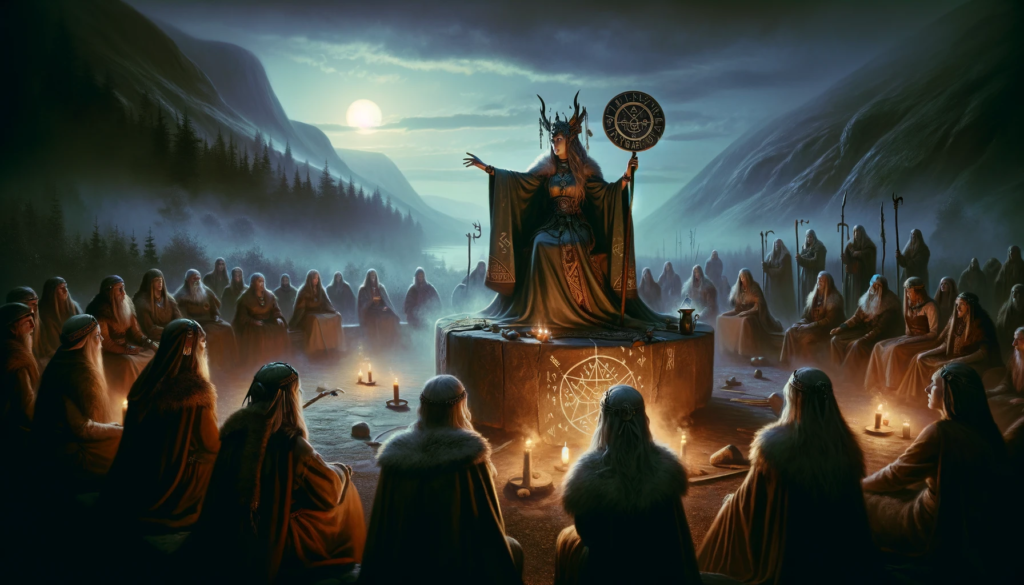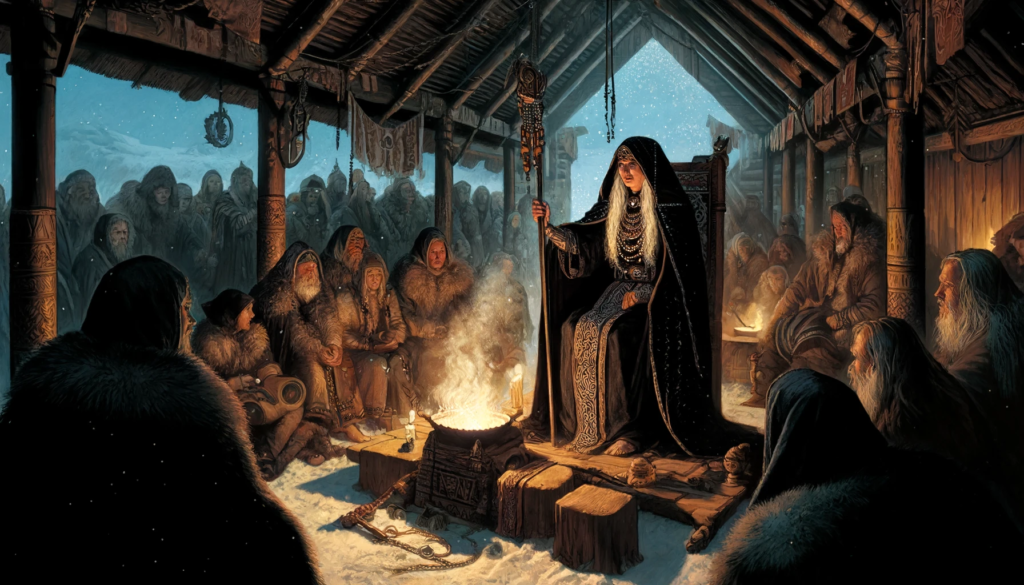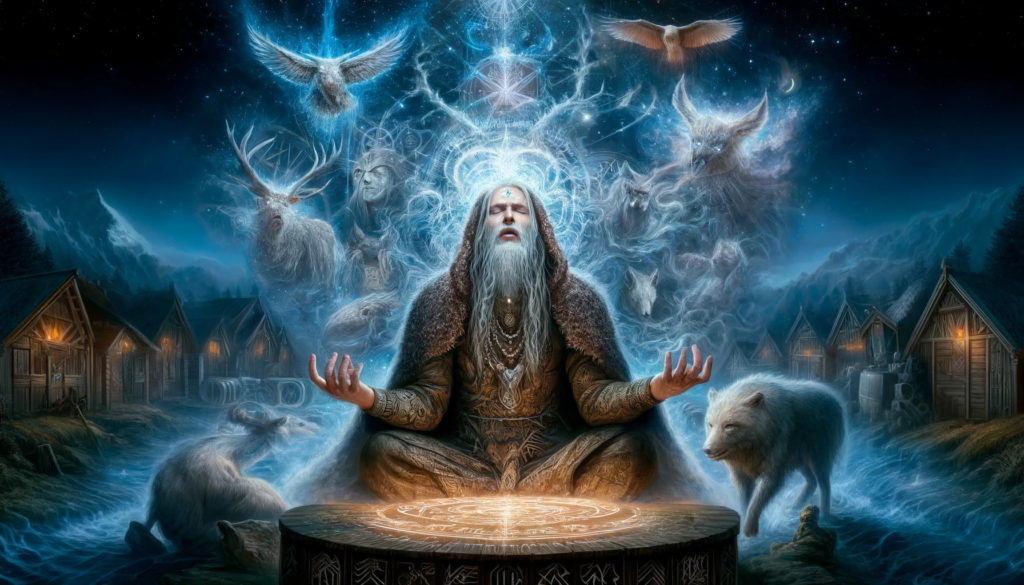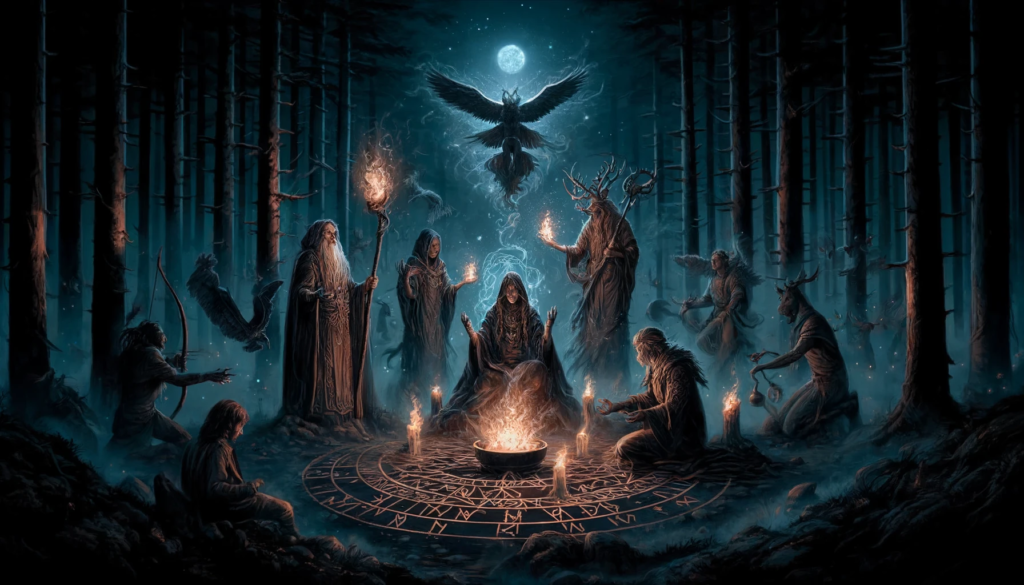Introduction to Shamanistic Components in Old Norse Tradition
Many recent studies have focused on the possibility of shamanistic components in the Old Icelandic and Old Norse tradition and both cognitive and ritualistic components in Norse were identified as shamanistic.
Shamanism is of course a ‘Kunstbegriff’ and was established in the 18th Century by western scholars (Flaherty, 2014). The question of what shamanism is depends on different theoretical frameworks and there is by no means a single, unified definition of shamanic practice.
Therefore, the question of European shamanism in Scandinavia and the Norse Icelandic tradition of Seiðr should include theoretical work that has been carried out in the field of ethnography and history of religion, examining the literature that has previously attempted to define what constitutes as ‘shamanistic’ and ‘shamanism’.

Table of Contents
Historical Perspectives on Norse Sorcery
Since Johan Fritzner’s work was published in 1877, scholars have debated whether Norse sorcery & magic, also known as Seiðr, was adopted from the neighboring Finno-Ugric-speaking Sámi population, whose ritualistic practice demonstrates many similarities to Siberia (Hultkrantz & Bäckman, 1978). Other hypothetical origins of Seiðr, as suggested by Åke Ohlmark (1939) are to be found in a common Indo-European heritage, rejecting the idea that Seiðr was similarly structured to the ritualistic practice of northern arctic and sub-arctic cultures of northern Eurasia.
The questions that arise here are manifold. How did visionary ritualistic practice evolve in pre-Christian Europe? And how does Seiðr compare to traditional Siberian shamanism?

Seiðr as a Type of Sorcery and Norse Magic
Seiðr was a type of European sorcery that was practiced in the northern regions of Europe. Seiðr has been likened to shamanism practiced in other parts of the world, such as in Central Northern Eurasia (Graham Harvey, 2003, p. 407). It is an Old Norse term for a very specific form of ritualistic practices performed mainly by skilled female seeresses“, however, this is not always the case. (Gardela 2008, 47).
The seer’s special language and the methods they used to contact supernatural powers, either bind or persuade them. The seeresses were known as völvur , which means “female bearer of a magic distaff. Here we also find the symbolism of the distaff used for the spinning of wool and textile. (Gardela 2008, 47, Gardela, 2016).
Seiðr has been the subject of much academic research, and there is still much debate surrounding its nature and origins. Some scholars argue that it is a form of shamanism, while others believe that we might have to completely revise our definition of Shamanism, and therefore, how cosmologies and rituals evolved in both Europe and in Asia.
Whatever the case may be, Seiðr was a significant part of Norse culture and played an important role in the lives of many people in the northern regions of Europe. Seiðr may have been much more important to the Norse cosmovision than previously understood, indeed, it may have been essential to the cosmology and structure of Norse society itself (Regis Boyer, 1986).

The Role of the Female Seeress in Norse Magic
The notion of a female Seeress, or Völva, sitting on a raised platform to induce altered states of awareness is also advanced by Strömbäck. We learn in the Hrolfs Saga that a wise woman sat on such a raised platform, known as the seiðhjallr, appearing to hyperventilate in order to reach a mental state where divinatory services could be performed for the community. Such services would often include so-called Galdrar, incantations and magical spells.
We also find that in the Saga of Erik the Red and the Vatnsdøla Saga, Seiðr was used for magical thievery and manipulation whilst entering an altered mental state that is required to perform the ritual.
These Seiðr rituals, it has been claimed, demonstrate striking cultural parallels to Saami and Finnish shamanism, therefore sparking the idea that the Norse adopted rituals from the neighboring Saami in Fenno-Scandinavia (Thomas Dubois, 1999, p. 126).

Shamanistic Traits in Norse Mythology
The idea that Norse mythology and consequently, Norse sorcery, is ‘shamanistic’ isn’t new. For example, the German scholar Franz Schröder argued in an article entitled Grímnismál from the year 1958 that Odin himself is a proto-type of a shaman, and his hanging on Yggdrasil, the world-tree of the Norse world, and his ability to shapeshift are shamanic capabilities.
Yggdrasil, as mentioned by Hilda Ellis Davidson, is an example of how shamanic lore may have also existed in Norse mythology, as the motif of a sacred world tree that grows through different layers of the world is also found among many traditionally shamanistic cultures in north Eurasia (Davidson, 1993, p. 69, Dillmann, 1993).
Textual Sources and Descriptions of Seiðr
Seiðr is mentioned in several textual sources and are mainly derived from Eddic poetry, Skaldic poetry, the sagas of kings and Icelandic family sagas. The earliest written source may be a 10th Century Skaldic poem called The Lausavisa of Vitgeir Seiðmaðr (Kari Ellen Gade, 2012), highlighting the practices of a Seiðr practitioner during the Viking Age.
According to the text, there was a Norwegian man who lived in Hǫrðaland (Hordaland), around 900, which is located in southwestern Norway. The word Hordaland actually derives from a North Germanic tribe, the Harudes, from Old Norse Hörðar. They were referred to as ‘forest-dwellers’.
The text says: it is [does] little harm that we perform sorcery, children of lowly men and women, when Rǫgnvaldr réttilbeini, Haraldr’s glorious son, performs sorcery in Hordaland. This has been described by various researchers as the earliest written text that mentions the Norse sorcery of Seiðr. There are, of course, also other primary sources that provide us with an ever deeper insight and greater detail into what Seiðr was and how it was practiced.
In the Icelandic Codex Regius, we may learn of the Völuspá (literally the Prophecy of the Völva) (22) (ibid. 6), there is a mysterious character called Heiðr, who is said to have introduced Seidr to the Aesir, despite the practice being unfavorable to the Gods. In the Ynglinga Saga, more importantly, it is said that it is Freya who teaches the art of Seiðr, again emphasizing the feminine nature of the art and practice of Seiðr.
Perhaps, the one of most detailed textual descriptions of Seiðr is found in the Icelandic ‘Eiríks saga rauða’, or the Saga of Erik the Red which takes place in Greenland, where a wise-woman, called Þorbjærg lítilvolva, is offering her ritualistic services sometime during the 10th century, although the exact dating has not been entirely determined.
To summarize the Seiðr-sitting in the Saga of Erik the Red, it was a custom of Völva Þorbjærg lítilvolva, to meet and gather up people during winter time. There, the Völva would offer her service to people who would like to know about their future, seasonal changes, and so on. In this particular instance, the Völva is asked for insights on when famine will come to an end.
The Seiðr ritual that took place in Greenland was probably brought over from northern Norway, representing the spread of Old Norse religion and its practices by Vikings. There she is asked for insights into when famine ends by a family of migrants.
The Saga was composed in the early 13th Century and has attracted much interest among scholars. Compiled and written down in two different manuscripts, the Hauksbók (14th century) and Skálholtsbók (15th century), the Eiriks saga rauda provides a highly detailed account on a Seiðr sitting, a form of magic deeply rooted in the Old Norse religion. (Hilda Ellis Davidson 1993, p. 137).
“A high seat was set for her, complete with a cushion. This was to be stuffed with chicken feathers. When she arrived one evening, along with the man who had been sent to fetch her, she was wearing a black mantle with a strap, which was adorned with precious stones right down to the hem.
About her neck she wore a string of glass beads and on her head a hood of black lambskin lined with white catskin. She bore a staff with a knob at the top, adorned with brass set with stones on top. About her waist she had a linked charm belt with a large purse. In it she kept the charms which she needed for her predictions.
She wore calfskin boots lined with fur, with long, sturdy laces and large pewter knobs on the ends. On her hands she wore gloves of catskin, white and lined with fur. When she entered, everyone was supposed to offer her respectful greetings, and she responded according to how the person appealed to her. Farmer Thorkel took the wise woman by the hand and led her to the seat which had been prepared for her.
He then asked her to survey his flock, servants and buildings. She had little to say about all of it. That evening tables were set up and food prepared for the seeress. A porridge of kid’s milk was made for her and as meat she was given the hearts of all the animals available there. She had a spoon of brass and a knife with an ivory shaft, its two halves clasped with bronze bands, and the point of which had broken off.”
The Völva responds:
“Many spirits are now present…which were charmed to hear the singing, and which previously had tried to shun us and would grant us no obedience. And now
many things stand revealed to me which before were hidden both from me and from others. (ch. 4, p. 83)
“I can now say that this famine will not last much longer and that conditions will improve with the spring; and the epidemic which has persisted for so long will abate sooner than expected.” (ch. 4).
Odin himself is reported to be able to perform Seiðr, although Seiðr itself is considered a taboo among males known as Ergi, meaning unmanly and deviant. In other instances, Seiðr was used in battle-magic, to inflict harm on enemies and even murder such as in the Laxdaela Saga, to affect the weather and outcome of crops and harvest (Clive Tolley, 2009, p. 141).
The Laxdaela Saga is written in its entirety in the Icelandic Möðruvallabók, a manuscript from the mid-14th century Chapter 33 is in so far interesting as it tells of a male practitioner, Gest Oddleifsson, who had insights into future events.

Other Types of Norse Sorcery
Various Forms and Functions
Among the Norse, there were at least 5 different types of sorcery, including Seiðr (binding and attracting), Galdr, Gandr (sent forth spirit, animal/shapeshifting helper spirits), Utiseta, and Odinnic magic. They overlap at times, such as Seiðgaldr and may have even a dual nature to them; they compliment each other in their function and purpose.
Galdr, for instance, linked to chanting and high-pitched singing (Price, 2002 p. 65). Shapeshifting animal-spirits would be sent forth to assist the Völva during and after her ritual in order to gain insights and knowledge about people or events (C. Tolley, 1995, p. 71).
Shamanic Techniques and Norse Magic Practices
As we learn from Mircea Eliade’s ‘archaic techniques of shamanism’(1964), traditional shamanism in Eurasia usually includes soul-travel by the shaman. Norse sorcery, on the other hand, also included trance.
According to Swedish anthropologist Hultkrantz, the concept of soul-travel is typical for north Eurasian and Fenno-Scandinavian types of shamanism, however, as he emphasizes, there appears to be a lack of such soul-travel in Norse rituals (Bäckman & Hultkrantz 1978, p. 20, Tolley, 1995, p. 58).
Dag Strömbäck’s “Sejd: textstudier i nordisk religionshistoria” (1935) is frequently cited in subsequent research papers and studies, even many decades after publication. According to
Strömbäck, Seiðr was formerly strongly linked with Odinnic magic and that there was significant cultural transmission between pre-Christian Scandinavian healing-systems and the rituals of the Saami, i.e., Finno-Ugric cultures.
Following Strömbäcks Sejd, much of the academic debate focused on two key issues: was Seiðr a native system of practices and beliefs inherent to pre-Christian northern Germanic cosmology, in other words, can its origins be traced back to a hypothetical common Indo-European ancestor, or was it perhaps adopted by the Saami? Both questions come with many problems, including ideological and political misuse of ethnographic study, which has happened tragically often during the 19th Century.
According to Almqvist (2000), Seiðr was used to attract things. The purpose of Seiðr was to influence desired events and outcomes in the future, to influence or to harm people, or to influence and manipulate natural events such as harvest of crops or even resources like fish. There is, however, broad agreement that Seiðr was an ecstatic kind of sorcery, as emphasized by Eldar Heide.
That is, the Seiðr practitioner could journey with the power of the mind while performing the rituals and chants and to even use spirits and spirit-helpers to do the will of the Völva (Eldar Heide, 2004, p.166. Such magical thinking certainly requires a specific mentality that operates in the background whilst performing such ritual and more importantly, the Norse understanding of the human soul appears to be central to the practice of Seiðr (Strömbäck, 1975).
Seen from this context, Norse magic and sorcery could be described as belonging to an underlying mentality with a set of practices that engage with the supernatural world on the basis of a shared reciprocity.
To summarize, in a Seiðr ritual a Völva would project her mind and spirit into the world in order to influence events and people, as well as future battle outcomes and agricultural harvests. This notion corresponds with Norse gandur, where a spirit sent forth/journeying/helping the Völva is linked to the breath and wind. Gandr being an Old Norse term that essentially means “spirit helper.
The words “breath,” “wind,” and “spirit” are frequently used interchangeably in northern Eurasia and amongst traditional shamanistic cultures (Heide, 2006). Both rituals contain the following components: recitation of magical strophes, ritual décor (doors and door hinges, as well as the door frame, and above all strong sexual overtones and the idea of peering into other
worlds or into the world of the dead. However, as noted by Clive Tolley, (1995), what is unclear is how important out-of-body soul travel was during Seiðr as compared to divinatory services with the help of guardian and/or shapeshifting helper spirits. (Gardela 2008, 67).

Shamanism, Ecstatic Cults, and Pre-Shamanic Ontologies
One of the most important aspects of shamanism is that it is not tied to any one culture or region. It is a tradition that can be found in a variety of cultures across the world, each with their own unique take on the practice. (M. Eliade, 1972). So, when we ask if Seiðr is shamanistic, we must first understand what shamanism is and how it developed. Only then can we begin to answer the question.
There are theoretical considerations and problems surrounding the definition and the very concept of what shamanism is, where it came from and how it developed. (Stefanie v. Schnurbein, 2003, p. 126). An often held assumption is that shamanism was already established and existent in the Paleolithic Stone Age, reflective in rock-art and cave-paintings.
However, as scholars from Russia, Hungary and the United States have shown, the origins of shamanism may be much more complex. Shamanism evolved with changes in culture, subsistence and the way a culture and a people related to themselves and the natural environment.
And there may be even older layers of rituals and cosmologies already existent before the emergence of what we call traditional Shamanism. This practice, termed animal-ceremonialism or more precisely, bear-ceremonialism, has been studied in depth by several scholars. (Paproth 1976, Hallowell 1926, Siikala, 2002)
As Russian ethnographers such as Anisimov and Vasilevich have written, the traditionally shamanistic Evenki consider the bear, whom they call Mangi, a shaman, ancestor and teacher to humans.
This belief in animal agents who possess agency, culture and personality – even supernatural and shamanic powers – has been suspected to belong to a pre-shamanic layer of ritual and belief among Siberian hunting cultures (Esther Jacobson 1993, p. 182). This mentality subscribes shamanistic-like powers to animals and humans alike and therefore communication between human and supernatural worlds is something that is an inherent ability to both human and animal.
Russian scholar Glafira Vasilevich (1975) proposed that there are rites and beliefs native to Siberia that might be pre-shamanic, such as cults of the hearth and the veneration for a guardian of animals. These evolved out of seasonal revival rituals and the assisting and participating ritualistically with the rebirth of game, nature and consequently, also humans.
The belief in an animistic nature, the supernatural and the power of the soul, however, typically emphasizing animals and spirits possessing agency, culture and personhood does not automatically involve shamanism, if we choose to see shamanism through the Siberian ethnographic lense.
Even more importantly, as Russian ethnographer Animisov writes, it was typical for the Evenki that every member of the community had equal access to shamanizing equipment. Therefore, if everyone was capable of potentially participating in shamanic rituals, and consequently to shamanize, could the development of a ritual specialist – a shaman – be a much more recent manifestation of an even older layer of both rituals and myths? (see Anisimov, 1964, p. 116).
As pointed out by Neil Price (2004), it is estimated that 60% of textual sources referring to Seiðr had an aggressive and harmful objective. However, the major difference between traditional shamanistic cultures of Eurasia, whose subsistence is based on hunting and gathering, and the Norse Scandinavians is that the latter had organized warfare.
As he further notes, there are many analogies between Seiðr and traditional circumpolar cultures. Neil Price even goes one step further, he says that in order to truly understand the role and function of Seiðr in the Norse worldview and mentality, it is of urgent importance to study the healing-systems of Greenland, Siberia and North America, as well.
The term ‘Circumpolar’ was coined by Norwegian Archaeologist Gutorm Gjessing in 1944 and refers to the common historical evolution of northern cultures, often emphasizing their hunter-gatherer origins that can be traced back to an arctic and sub-arctic nomadic lifestyle and subsistence that is reflected in their native cosmological belief-systems and rituals.
Thus, the question of whether Seiðr is shamanic, is deeply interwoven with the way Norse society is constructed, how power and identity is shaped by subsistence and the ecology of Norse society itself. The belief in an immaterial soul and the power of the mind extending beyond and outside the human physical body had to be fundamental to the practice of Seiðr, closely associated with the völva, a practitioner of seidr in Viking society.
For Dag Strömbäck, the soul in Norse Scandinavian cosmology was capable of extending beyond the physical body in order to influence, attract and manipulate during the practice of Seiðr (1975, 16). This ability and concepts of Norse spirits such as fylgjur (sg. fylgja), hamingjur (sg. hamingja), and dísir (sg. dís) would further raise the possibility that Seiðr was ‘shamanic’. For
the Swedish scholar Åke Ohlmark (1939), Seiðr wasn’t shamanic in the sense that traditional Eurasian shamanism wasn’t comparable to the healing-systems of Indo-European origin and its assumed pastoralist/animal herding culture.
Romanian scholar Mircea Eliade, well known for his classic work ‘shamanism: archaic techniques of ecstasy’ proposed that the animal skulls and bones found during the Aurignacian Period in the Upper Paleolithic in Europe may depict offerings in ritualistic animal-ceremonialism.
He further notes that shamanism itself may have emerged as a practice by 25,000 B.C., and that the cave paintings in France, particularly in sites such as Lascaux and Chauvet, may depict the earliest shamanistic representations via anthropomorphic symbolism. This shaman theory in particular has influenced a great number of scholars since the 1960’s, who would often refer to the shamanistic elements within the greater context of a Paleolithic hunter-gatherer tradition (Eliade, 1972, p. 503).
A highly problematic venue of research was the search for a common ancestor (Urheimat, Ursprache, Urvolk) which was often highly influenced by political ideologies of that time (see also Stefanie v. Schnurbein, 2003). If shamanism was practiced also in Europe, who brought it to Europe and when?
Indo-European steppe-herders during the Bronze Age, Neolithic farmers by 5500 BC in central Europe, or Mesolithic hunter-gatherers after they’ve left their Ice Age refugia in Iberia and migrated further north? For instance, the German scholar Buchholz argued that Seiðr was likely to be indigenous to the north Germanic Scandinavians, who may have inherited their cosmology and rituals from much older beliefs that can be traced back to European hunter-gatherers in pre-agricultural Europe (Buchholz, P. 1968, pp. 9, 10).
For Ivar Paulson (1964, p. 131) the central components of shamanism are techniques of ecstasy and inducing alternative states of consciousness in order to ‘shamanize, to heal, negotiate and communicate with the spirit-world, but did these also exist in Europe?

Shamanism in Europe?
Let us turn to the work of the swedish anthropologist Åke Hultkrantz who contributed a significant body of research in regards to the concept of circumpolar proto-mythology. Åke Hultkrantz claims that such belief-systems mainly stem from the worship of animal ceremonialism, totemism and bear ceremonialism (in particular), as well as an animist worldview regarding trees, stones and other sacred sites, and finally the practice of shamanism. (Hultkrantz, 1996, p.31). However, such practice appears to have developed within hunting-cultures, which emphasize the importance of rebirth of game and the cyclical forces of nature, and ultimately life and death. (see e.g., Deborah J. Shepherd, 1995, Singh Manvir 2018, M. Winkelman, 2002). Europe, including Scandinavia, did not live a hunter-gatherer way of life and mode of subsistence for a long time prior and during the Viking Age.
In Siberia, the literature demonstrates very strongly that shamanism arose out of seasonal renewal ceremonies that revolved around the movements of the sun, where the rebirth/resurrection of game, the sun and of nature overall played an essential role among traditional hunting cultures. (M. Hoppal, 2006, A. L. Siikala & Hoppal, 1992).
Another Swedish scholar named Åke Ohlmark, too, assumes that the origins of traditional shamanism are rooted in an arctic environment and therefore, Scandinavians with their assumed Indo-European heritage had little to no shamanistic elements. This notion is grounded in the proposed Indo-European Urheimat which is believed to be near the Caspian Steppe in what is today Ukraine. Consequently, none of the Indo-European ancestors had a ‘traditional’ hunter-gatherer cultural background.
Furthermore we may turn to what scholar J. Fleck argues in ‘Griminsmal: The Case against ‘Shamanism’ (1971) that Seidr and Odinnic magic is not related or linked to Siberian shamanic practice. The basis of these arguments seem to lie again in the Steppe Theory of Indo-European cultures and consequently, their beliefs and rituals. Perhaps, the question of the origins of Seiðr lies somewhere in the middle, what has been argued by Thomas Dubois: While Seiðr shows striking parallels to the shamanism of Sami and Fenno-Finns, it could also be that Seiðr is an amalgamation of pre-existing healing-systems consisting of rituals and beliefs among pre-Christian Scandinavians and cultural transfer/contact. (Dubois, 1999, p.137). And therefore, Seiðr consists of multiple time layers and from different cultures.
Perhaps, the question is not so much about how shamanism evolved in Siberia and, as a result, the term shamanism might not be useful in order to reconstruct these deeper layers of pre-Christian mentalities. We, instead, might have to carefully differentiate between dream cults, ecstatic cults and finally shamanism as distinct types of visionary and ritualistic practice as written in the round-table discussion of ‘Witchcraft mythologies and persecutions’ (2008, p. 36), the term shamanism should not be applied so easily to European witchcraft and ritual healers, especially because the term ‘shamanism’ tends to overgeneralize ritualistic processions and the belief-systems associated with it.
On the other hand, the question of searching for shamanism outside of its Eurasian sociocultural context has been widely debated and with mixed results. However, there are scholars who have argued that a type of Eurasian shamanism may indeed have been inherited from older cultures among the so-called Indo-European step-herders. How ‘shamanism’ in Europe evolved and how similar it was to Asia in both cognition and cultural evolution is still very much in need for further research, including if the term ‘shamanism’ applies to pre-Christian Europe or if there is a need for an entirely new theoretical framework (Clive Tolley, 2009).
How such cults may have evolved over time since pre-Christian times is a complex field of research and consequently should be treated with great care and in a nuanced fashion. There is, however, promising research in regards to the concept of animistic ontologies and whether pre-Christian cultures in Europe such as the Norse shared cosmological features of other northern and north Eurasian cultures.
Animism as a relational epistemology could have evolved in pre-Christian Europe in similar ways as it has in Eurasia due to quite similar ecological and economic conditions since pre-agricultural times (Enrico Comba, 2013, Bird-David, 1999, Zvelebil, 1997). Therefore, a similarly structured set of myths and rituals that are likewise expressed in visionary ritualistic practice could be the result of how ecology, i.e., human-nature relationships manifest in ritual, belief and vision-quest practices.
It appears as if European ritualistic specialists, healers and experts who are able to communicate between ‘liminal spaces’ show striking parallels to Eurasian and/or indigenous Siberian counterparts. However, there are elements that are also unique to Europe and do not play an important role west of the Urals.
Perhaps, the answer lies in the mentality of European pre-Christian hunters, farmers and pastoralists combined over time. If so, we may end up with a highly complex mosaic kind of image instead of a simple ‘yes’ or ‘no’ answer. If shamanistic traits are to be found for instance in Norse Magic, the question really lies in figuring out how visionary cults in Europe evolved relative to Eurasian visionary cults, bearing in mind deeper and more recent cognitive and cultural layers.
Does this possibly explain why there are seemingly ‘shamanistic’ traits in Norse sorcery & magic, possibly influenced by the revered position of the völva in practicing forms of magic akin to shamanistic practices? More research carried out by Hexenkunde will be presented in future articles and presentations.

References cited:
Almqvist, B. 2000. I marginalen till Sejd In G. Gidlund (ed.) Sejd och andra studier i nordisk själsuppfattning , 237–7 Upp-sala/Hedemora: Kungl. G. A. Akademien/Gidlunds förlag
Bäckman, L., & Hultkrantz, A. (1978). Studies in Lapp shamanism. Stockholm: Almqvist & Wiksell International.
Bek-Pedersen, K. (2009). Fate and Weaving: Justification of a Metaphor. Viking and Medieval Scandinavia, 5, 23–39. http://www.jstor.org/stable/45019118
Buchholz, P. 1968. Schamanistische Züge in der altisländischen Überlieferung. Münster. Paulson, I. (1964). Zur Phänomenologie des Schamanismus, Zeitschrift für Religions- und Geistesgeschichte, 16(2), 121-141. doi: https://doi.org/10.1163/157007364X00025
Bird‐David, N. (1999). “Animism” Revisited: Personhood, Environment, and Relational Epistemology. Current Anthropology, 40(S1), S67–S91. https://doi.org/10.1086/200061
Boyer Régis. (1986). Le monde du double : la magie chez les anciens scandinaves. Berg international.
Comba E. Amerindian Cosmologies and European Prehistoric Cave Art: Reasons for and Usefulness of a Comparison. Arts. 2014; 3(1):1-14. https://doi.org/10.3390/arts3010001
Clive Tolley (2009). Should we search for shamanism outside Siberia? The Nordic dilemma’. Folklore Fellows’ Network.
Clive Tolley (2009). Shamanism in Norse Myth and Magic. Suomalainen Tiedeakatemia, Helsinki.
Clive Tolley (1995). Võrðr and gandr: helping spirits in Norse magic’, Arkiv för nordisk filologi.
Price N. S. & Uppsala universitet. (2002). The viking way : religion and war in late iron age scandinavia (dissertation). Dept. of Archaeology and Ancient History.
Dronke, Ursula. (1969). The poetic Edda. London: O.U.P.
Davidson H. R. E. (1999). The lost beliefs of northern europe. Barnes & Noble.
Dillmann, François-Xavier. 1993. ‘Seiður og shamanismi í Íslendingasögum’. Skáldskaparmál, 1993, 2, pp. 20-33.
DUBOIS, Thomas A. Nordic Religions in the Viking Age. Philadelphia: University of Pennsylvania Press, 1999.
Eirik’s Saga. The Vinland Sagas: The Norse Discovery of America. Tr. Magnus Magnusson and Hermann Pálsson. Penguin Classics ed. London, Penguin, 1965. All quotations are from this edition.
Eiríks saga rauða. Ed. Guðni Jónsson. Heimskringla.no
The Saga of the People of Laxardal. Tr. Keneva Kunz. The Sagas of Icelanders. Ed. Örnólfur Thorsson. New York: Viking-Penguin, 2000.
Eliade, M. (1972). Shamanism: archaic techniques of ecstasy. Princeton, N.J.: Princeton University Press.
Flaherty G. (2014). Shamanism and the eighteenth century (Course Book). Princeton University Press. https://doi.org/10.1515/9781400862641
Fritzner, J. 1877. Lappernes Hedenskab og Troldomskunst sammenholdt med andre Folks, isaer Nordmaendenes Tro og Overtro. Historisk Tidskrift 4. Christiania.
Franz Rolf Schröder, “Grímnismál,” Beitr, 80 (Tiibingen, 1958), pp. 341-78
Fleck, Jere. The ‘Knowledge-Criterion’ in the Grimnismál: The Case against ‘Sha- manism,’ ” Arkiv för Nordisk Filologi 86 (1971):
Kari Ellen Gade 2012, ‘ Vitgeirr seiðmaðr, Lausavísa’ in Diana Whaley (ed.), Poetry from the Kings’ Sagas 1: From Mythical Times to c. 1035. Skaldic Poetry of the Scandinavian Middle Ages 1. Turnhout: Brepols.
Gardela, Leszek. (2008) “Into Viking Minds: Reinterpreting the Staffs of Sorcery and Unravelling Seiðr.” Viking and Medieval Scandinavia.
Gardeła, L. (2016). Magic) Staffs in the Viking Age (Studia Medievalia Septentrionalia 27. Vienna: Verlag Fassbaender, 2016. ISBN 978-3-902575-77-7). European Journal of Archaeology, 21(3), 495-498. doi:10.1017/eaa.2018.24
Hoppál, Mihály. (2006). Shamanic and\or cognitive evolution. Documenta Praehistorica. 33. 10.4312/dp.33.20.
Hallowell A. I. (1926). Bear ceremonialism in the northern hemisphere (dissertation). University of Pennsylvania.
Heide, Eldar. Spirits Through Respiratory Passages. In John McKinnel et. al (eds.): The Fantastic in Old Norse / Icelandic Literature. Sagas and the British Isles. Preprint Papers of The 13th International Saga Conference, Durham and York, 6th-12th August, 2006. [Durham]: [University of Durham]. 350-58.
Heide, Eldar. Spinning Seidr. International Conference Old Norse Religion in Long-Term Perspectives: Origins Changes and Interactions Andrén Anders Jennbert K. & Raudvere C. (2004). Old norse religion in long-term perspectives : origins changes and interactions : an international conference in lund sweden june 3-7 2004. Nordic Academic Press.
Harvey, Graham. (2003). Shamanism: A reader. London: Routledge.
Jacobson E. (1993). The deer goddess of ancient siberia : a study in the ecology of belief. E.J. Brill.
Michael, Henry N. (editor) (1964). Anthropology of the North: Translations from Russian Sources: the Archaeology and Geomorphology of Northern Asia: Selected Works. University of Toronto Press.
Pócs Éva. (1999). Between the living and the dead : a perspective on witches and seers in the early modern age. Central European University Press ; Distributed in the U.S. by Cornell University Press Services. Retrieved August 24 2022 from http://search.ebscohost.com/login.aspx?direct=true&scope=site&db=nlebk&db=nlabk&AN=4605 9.
Pócs Éva Klaniczay Gábor & Csonka-Takács Eszter. (2008). Witchcraft mythologies and persecutions. Central European University Press.
Pentikäinen Juha & Regional Conference on Circumpolar and Northern Religion. (1996). Shamanism and northern ecology. Mouton de Gruyter. Retrieved August 24 2022 from https://doi.org/10.1515/9783110811674.
Singh, Manvir (2018). The cultural evolution of shamanism. Behavioral and Brain Sciences 41.
Shepherd, D. (2018). BEAR, ELK, AND FISH SYMBOLISM IN FINNISH CONTEXTS. In K. Ryan & P. Crabtree (Ed.), The Symbolic Role of Animals in Archaeology (pp. 27-38). Philadelphia: University of Pennsylvania Press. https://doi.org/10.9783/9781949057003-004
Siikala, A. (2002). Myth and Mentality: Studies in Folklore and Popular Thought.
Schnurbein, S. (2003). Shamanism in the Old Norse Tradition: A Theory between Ideological Camps. History of Religions, 43(2), 116–138. https://doi.org/10.1086/423007
Strömbäck, Dag. 1975. The concept of the soul in Nordic tradition. Arv 31: 5-22. Strömbäck, Dag. 1935. Sejd: textstudier i nordisk religionshistoria. Gebers, Stockholm.
Timm E. (2010). Frau holle frau percht und verwandte gestalten 160 jahre nach jacob grimm aus germanistischer sicht betrachtet (2. Aufl). Hirzel
Vasilevich G. M. Doshamanskie i shamanskie verovaniya evenkov [Pre-shamanistic and shamanistic beliefs of the Evenks] hi: Sovetskaya etnografiya [Soviet Ethnography], 1975.
Winkelman, M. (2002). Shamanism and Cognitive Evolution (with comments). Cambridge Archaeological Journal, 12(1), 71-101. doi:10.1017/S0959774302000045
